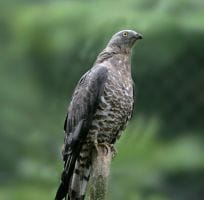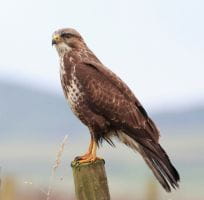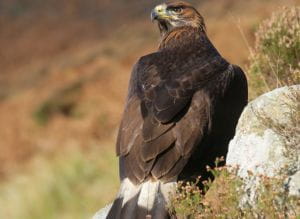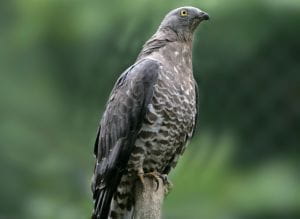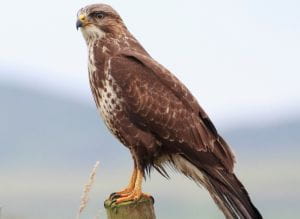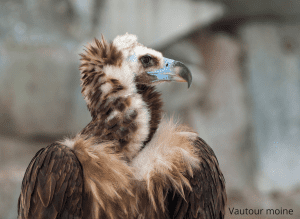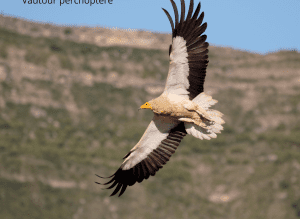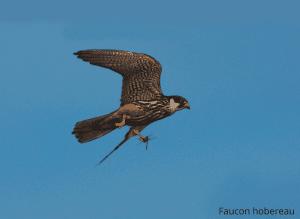The Golden Eagle
Aquila chrysaetos
One of the largest birds of prey living in France: up to 2.30 m wingspan, weighing 6.5 kg.
Generally sedentary. Solitary or in monogamous pairs, living on a vast main range with a series of secondary ranges enabling them to expand their hunting territory.
The golden eagle feeds on rodents, marmots, hares and other mammals such as foxes and roe deer, as well as medium-sized birds such as mallards.
It breeds at the end of the summer.
It tends to breed in late winter/early spring. Brooding (2 to 4 eggs) lasts 45 days, and is mostly carried out by the female, with the male taking care of provisioning. But she may also brood. The eaglets remain in the nest for just under 3 months.
After this period, only one or two young will take flight and remain near their birth area until the following winter.
The Honey Buzzard
Pernis Apivorus
This raptor is migratory and can be seen on La Réserve in May and again between August and September.
The Bondre’s diet is highly atypical. Like many raptors, it can feed on small vertebrates, but its name “apivorus” was given for its affection for bees, bumblebees, wasps and their larvae.
To do this, the Bondreus has developed several hunting adaptations: either in flight for the imagos (adult stage of the insect), or on the prowl to better spot the movement of its future prey. She then uses her talons to dig into the ground in search of the honeycombs where the larvae are hidden. She can dig up to 30 cm deep!
As for stings, there’s little risk! The Bondrea is equipped with short, compact feathers around the beak and eyes to protect itself.
The Common Buzzard
Buteo buteo
One of the best-known birds of prey. Its name has been used since the 16th century to describe fools. In fact, it reflects the falconers’ inability to train it. They deduced that this bird of prey was stupid and preferred the hawk, which they considered much more intelligent. “A hawk cannot be made from a buzzard”.
Buzzard “variable” because its plumage and the patterns that adorn it are highly variable in color.
Hawks are monogamous, sedentary and territorial. However, on La Réserve, they have to contend with the territoriality of crows and great ravens, which are more numerous and often have the upper hand. A real sinecure!
These predators mainly hunt small mammals, but we sometimes observe them feeding on reptiles, smaller birds, or insects.
They are known to be noisy. In spring, a mewing-like call can be heard in flight.
The Short-toed Eagle
Circaetus gallicus
This migratory bird of prey can be seen every year on La Réserve. It winters in Africa but spends spring and summer in our latitudes.
It happens to observe a circaetus in flight with a branch in its beak. This does not necessarily correspond to a nest being built. He wants to signal to other birds of prey that the pair has just found a favorable nesting site. For several days, the male and female pass the twig from leg to beak, in concentric flights over the site. The persistence of the ceremonial bears witness to the taking of territory from other individuals.
This raptor feeds mainly on reptiles, especially snakes. In order to allow the chicks to consume them, the adults swallow the prey only partially, leaving the end of the tail protruding from the beak.
The laying period (1 egg) is from late March to mid-May. Incubation lasts around 45 days, with brooding mainly carried out by the female.
The youngster is ready to fledge at 2 and a half months.
Vultures
There are 6 species of vulture in Europe, 4 of which nest in France. These large, broad-winged birds of prey are scavengers. They travel by gliding, in search of thermal updrafts.
Among the French species, three are regularly observed on La Réserve: the Griffon Vulture, the Monk Vulture and the Egyptian Percnopter.
The Bearded Vulture, meanwhile, is more discreet, but GPS beacons indicate that some individuals fly over La Réserve without ever landing.
The Griffon Vulture
Gyps fulvus
This is the most common species, the one that does best on our territory but whose populations remain protected. The Griffon Vulture is the first species to land on carrion. Its bare neck allows it to pass through the natural orifices of the carcass and feed on the muscles and viscera of the deceased animal.
Mating flights, the most common of all species of vulture, take place on the ground.
Synchronous nuptial flights can be observed as early as December. These birds are monogamous, and the pair bond can last a lifetime. Their reproductive success is low, however, as only one egg is laid in the nest, and some birds such as great crows or ravens take advantage of even the slightest absence of the parents to feast on them!
The Black Vulture
Aegypius monachus
It is, along with the Bearded Vulture, Europe’s largest bird. One of the most endangered too, since it is on the IUCN red list and on the list of strictly protected species da the Bern Convention.
More discreet and rarer than the Griffon Vulture, with which it may share its habitat. The Black Vulture is regularly observed in the midst of Griffon Vulture colonies, even though it prefers an isolated pair life to life in a colony.
In 2024, 7 pairs of this species were present in the Gorges du Verdon, settled among the hundred or so Griffon Vulture pairs!
This strict scavenger has a preference for tough parts: tendons, skin and cartilage. But it will also feed on viscera and muscles if the first arrivals, i.e. Griffon Vultures, have not been too voracious.
On the other hand, on a carcass of a bird, it’s easy to see why.
On the other hand, on a “cleaned” carcass, the Black Vulture dominates all other vulture species.
The Egyptian Vulture
Neophron percnopterus
The French population of this species is thought to number no more than 100 pairs, and its range is restricted to the Pyrenees (70 pairs) and the southeastern Mediterranean (10 pairs)
At La Réserve, we are lucky enough to be able to observe 1 or 2 individuals every summer, as some Percnoptera settle in the Gorges du Verdon in spring. They then follow the movements of the sedentary vultures to search out and learn about their feeding grounds.
Although known to prefer the tendons of carcasses, the Percnopteron is the least strict of scavengers. It will occasionally consume eggs and small prey. In fact, it is one of the few Palearctic birds to have developed the ability to use tools such as pebbles, This is how it breaks ostrich eggs in their wintering quarters in Africa.
The Bearded Vulture
Gypaetus barbatus
This majestic raptor is the most endangered of the 4 French vulture species. Its populations are small and its breeding successes are few: just 80 pairs spread between the Pyrenees, Corsica and the French Alps, including 5 pairs living in the southern Alps (04 and 06).
The Bearded Vulture is known as the last of the carrion birds to pass over a carcass. It specializes in consuming the bony parts of corpses, and can ingest bones up to 25 cm long and 3 cm thick. To do this, it has a wide beak opening, an elastic gullet and a keratinized esophagus wall. In addition, the esophagus is devoid of a crop, as is the case with nocturnal birds of prey.
If the bones are too big for the Bearded Vulture to eat, it flies off and drops them from above to break them. If necessary, he repeats the operation as many times as necessary, until he can swallow the fragments.
The digestion of this very special diet is made possible by the production of very powerful gastric acids capable of releasing the proteins, fats and minerals contained in the bones.
Hawks
Hawks are part of the falconiformes. The genus includes different species with varying sizes, plumages and behaviors. However, this group has a fairly flexible diet, feeding on small mammals as well as insects and reptiles.
In courtship, after circular or acrobatic flights, chases and various behaviors the male offers one or more prey items to the female, in all species.
The kestrel
Falco tinnunculus is a sedentary species, sometimes partially migratory. It is a very common raptor, present in a wide variety of habitats. It is easy to spot with its “Holy Spirit” hovering flight. Outside breeding periods, the kestrel is a solitary bird of prey.
The hobby falcon
Falco subbuteo is a migratory, fairly territorial species. It can be seen in summer on La Réserve and has a very fast flight. Its agility enables it to catch small birds such as swifts and swallows in flight!
A special feature? This bird of prey lays its eggs late in the summer.
The peregrine falcon
Falco peregrinus is probably the best-known of all falconiform species. It is also one of the largest. Sedentary or migratory, this falcon is monogamous and faithful to its nesting site for years.
This fearsome predator hunts in a variety of ways. Often in flight, where it pounces on its prey, with peak speeds of over 350km/h, but also by stalking towards the ground over distances of up to a kilometer!
It lays between late February and early April – 3 or 4 eggs. The 2 parents take turns incubating the eggs.

